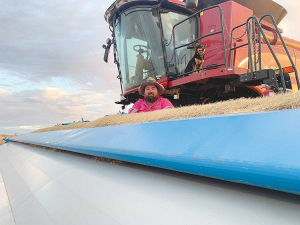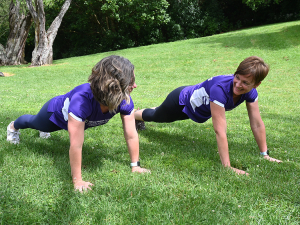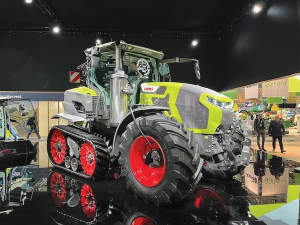Robinson farms at Hoyleton, north of Adelaide, with his partner Cassi and his parents Ashley and Kaylene. They farm 1,540ha of wheat, barley, canola, peas and lentils.
The Robinson family initially adopted no till as a way of managing and retaining as much crop residues on the soil surface as possible for moisture conservation in their hot, dry climate.
They have been minimum till and then no-till for 25 years. The Robinsons have implemented a number of changes to help improve their soils. These include use of a Shelbourne stripper header front to help retain stubble, controlled traffic system to help manage soil compaction, summer cover crops, decreasing fertiliser inputs, and more recently, companion cropping and intercropping.
The farm has a 325 to 425mm annual rainfall, which predominantly falls in winter. In summer it bakes, with temperatures above 40 degC and annual evapotranspiration of 3,000mm. The soil type is red brown earth and some loam over clay, with organic matter between 1 to 2%.
A lack of moisture is their biggest limiting factor. Therefore, the benefits of moisture conservation mean that district average wheat yields are 4 tonne/ha under no till and full input – double those under full tillage and full input.
Robinson says no till is the biggest change on the farm for 160 years.
A disc seeder was purchased to handle the crop residue. Robinson explained that there are four principles for disc seeding, “cut, place, press and cover”.
The Robinsons’ John Deere 1890 disc seeder is able to sow directly into heavy stubble and is modified with a narrow gauge wheel. As downward pressure is important, 1.5 tonnes of weight has been added.
“We aim for two inches (5cm) of spring compression which provides downward pressure on to the discs. Too many people don’t run enough downward pressure to get correct seed placement and correct cut.
To gain more even crop residue across their paddocks the Robinsons purchased a Shelbourne stripper header, a type of combine harvester which removes the grain from the plant, leaving the stem standing in the field. This has led to a 30 to 50% increase in harvester capacity in cereals and a similar amount in fuel savings, depending on the conditions.
“Not putting the amount of straw through of a conventional draper header is saving a lot of horsepower and diesel,” Robinson adds.
The Robinsons have also adopted controlled traffic farming, taking six years to change their machinery over to the 30m system. Advantages were improved yields of 10 to 40% and fuel savings, as well as improved soil with faster water infiltration.
However, Robinson says he probably won’t continue with this, as no till, the stripper header, crop rotation and livestock rank higher – particularly as the farm’s soil structure improves.
Summer cover crops are grown, with each having its own purpose, either for soil health or to feed livestock. The farm had no livestock for 28 years until 2018, when cattle were introduced and these work well with cover crops, which are sown through the standing harvested crop.
“We like sunflowers here,” Robinson adds. “They don’t have much ground coverage, but they have a big taproot and are hardy in our hot summers. Tillage radish is grown for livestock.”
They have no issues with a disc seeder running through a cover crop.
Robinson recommends that farmers adopting no till terminate a cover crop three to four weeks before seeding, leaving an unsprayed test strip to see whether this would work in their own situation. “We find that material breaks down fairly quickly. That’s where trial work is needed on your own farm.”
He is a fan of companion crops, successfully growing peas and canola together, as well as lentils and linseed.
In response to a question about the limited ability to use a brassica as a cover crop, particularly in Canterbury, because of its export brassica seed market, Robinson says that companion planting is about adding things that weren’t normally in the rotation.

















